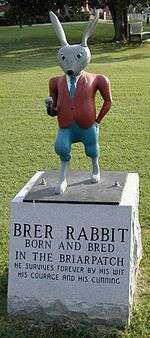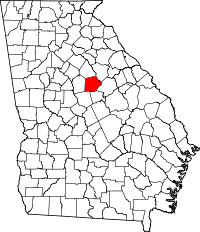Eatonton, Georgia
| Eatonton, Georgia | |
|---|---|
| City | |
|
Putnam County Courthouse in Eatonton | |
 Location in Putnam County and the state of Georgia | |
| Coordinates: 33°19′35″N 83°23′16″W / 33.32639°N 83.38778°WCoordinates: 33°19′35″N 83°23′16″W / 33.32639°N 83.38778°W | |
| Country | United States |
| State | Georgia |
| County | Putnam |
| Area | |
| • Total | 20.7 sq mi (53.5 km2) |
| • Land | 20.6 sq mi (53.2 km2) |
| • Water | 0.1 sq mi (0.3 km2) |
| Elevation | 568 ft (173 m) |
| Population (2010) | |
| • Total | 6,480 |
| • Estimate (2016)[1] | 6,555 |
| • Density | 327/sq mi (126.4/km2) |
| Time zone | Eastern (EST) (UTC-5) |
| • Summer (DST) | EDT (UTC-4) |
| ZIP codes | 31024 |
| Area code(s) | 706 |
| FIPS code | 13-26084[2] |
| GNIS feature ID | 0331628[3] |
| Website | City of Eatonton |

Eatonton is a city in and county seat of Putnam County, Georgia, United States.[4] As of the 2010 census, the city had a population of 6,480.[5] It was named after William Eaton,[6] an officer and diplomat involved in the First Barbary War. The name consists of his surname with the English suffix "ton," meaning "town".
History
The Rock Eagle Effigy Mound, a Native American archaeological site, is located north of the city. It is one of two such sites east of the Mississippi River; both are in Putnam County. The mound and related earthwork constructions were made by Woodland culture peoples, perhaps as long ago as 1,000 to 3,000 years. The site within a 1500-acre park administered by the University of Georgia, which also maintains a 4-H camp nearby. The Mound has been listed on the National Register of Historic Places.
Following the American Revolutionary War, Eatonton was founded in 1807 as the seat of newly formed Putnam County. After the war, settlers were moving west and settling in the upland Piedmont region to develop cotton plantations. Eatonton was incorporated as a town in 1809 and as a city in 1879.[7]
In the 21st century, Eatonton is known as the "Dairy Capital of Georgia" (in honor of its major industry, dairy farming).
Geography
Eatonton is located at 33°19′35″N 83°23′16″W / 33.32639°N 83.38778°W (33.326302, -83.387798).[8]
According to the United States Census Bureau, the city has a total area of 20.7 square miles (54 km2), of which 20.6 square miles (53 km2) is land and 0.1 square miles (0.26 km2) (0.63%) is water.
Demographics
| Historical population | |||
|---|---|---|---|
| Census | Pop. | %± | |
| 1840 | 516 | — | |
| 1860 | 2,009 | — | |
| 1870 | 1,240 | −38.3% | |
| 1880 | 1,371 | 10.6% | |
| 1890 | 1,682 | 22.7% | |
| 1900 | 1,823 | 8.4% | |
| 1910 | 2,036 | 11.7% | |
| 1920 | 2,519 | 23.7% | |
| 1930 | 1,876 | −25.5% | |
| 1940 | 2,399 | 27.9% | |
| 1950 | 2,749 | 14.6% | |
| 1960 | 3,612 | 31.4% | |
| 1970 | 4,125 | 14.2% | |
| 1980 | 4,833 | 17.2% | |
| 1990 | 4,737 | −2.0% | |
| 2000 | 6,764 | 42.8% | |
| 2010 | 6,480 | −4.2% | |
| Est. 2016 | 6,555 | [1] | 1.2% |
As of the census[2] of 2000, there were 6,760 people, 2,553 households, and 1,817 families residing in the city. The population density was 329.1 people per square mile (127.0/km²). There were 2,723 housing units at an average density of 129.8 per square mile (50.1/km²). The racial makeup of the city was 35.50% White and 64.50% African American.
There were 2,553 households out of which 34.9% had children under the age of 18 living with them, 40.4% were married couples living together, 24.0% had a female householder with no husband present, and 30.1% were non-families. 26.2% of all households were made up of individuals and 10.0% had someone living alone who was 65 years of age or older. The average household size was 2.66 and the average family size was 3.20.
In the city, the population was spread out with 9.8% from 18 to 24, 29.3% from 25 to 44, 20.3% from 45 to 64, and 12.0% who were 65 years of age or older. The median age was 34 years. For every 100 females there were 90.1 males. For every 100 females age 18 and over, there were 87.9 males.
The median income for a household in the city was $23,391, and the median income for a family was $29,751. Males had a median income of $24,883 versus $18,193 for females. The per capita income for the city was $12,951. About 20.4% of families and 25.1% of the population were below the poverty line, including 32.5% of those under age 18 and 16.4% of those age 65 or over.
Education
Schools in the area
The Putnam County School District holds grades Headstart to grade twelve, and consists of one primary school, an elementary school, a middle school, a high school, and an alternative school.[10] The district has 165 full-time teachers and more than 2,474 students. Gatewood Schools, a private Christian school in the area serves children in grades K3-12. [11]
- Gatewood Schools (K3-12)
- Putnam County Primary School
- Putnam County Elementary School
- Putnam County Middle School
- Putnam County High School
- Putnam County Achievement Academy
Notable people
Vincent Hancock, Olympic gold medalist in men's skeet shooting at the 2008 and 2012 Summer Olympics and Gatewood Schools graduate, resides in Eatonton.[12]
The city is the birthplace of several noted writers, such as Joel Chandler Harris (journalist and author of the Uncle Remus stories), Henry Grady Weaver, author of The Mainspring of Human Progress, and Alice Walker, author of the novel The Color Purple and other fiction.
S. Truett Cathy, founder of Chick-fil-A fast food restaurant and franchise, is a native of the town.
Rick Brewer, former administrator at Charleston Southern University in North Charleston, South Carolina, and current president of Louisiana College in Pineville, Louisiana, is a former resident of Eatonton.[13][14]
Tornado
On November 22, 1992, an F4 tornado with winds up to 260 mph hit the south portions of the city. The storm caused $27,000,000 in damages to houses and businesses. The tornado took five lives and injured 86 persons.
References
- 1 2 "Population and Housing Unit Estimates". Retrieved June 9, 2017.
- 1 2 "American FactFinder". United States Census Bureau. Retrieved 2008-01-31.
- ↑ "US Board on Geographic Names". United States Geological Survey. 2007-10-25. Retrieved 2008-01-31.
- ↑ "Find a County". National Association of Counties. Archived from the original on 2012-07-12. Retrieved 2011-06-07.
- ↑ http://quickfacts.census.gov/qfd/states/13/1326084.html
- ↑ Gannett, Henry (1905). The Origin of Certain Place Names in the United States. Govt. Print. Off. p. 113.
- ↑ Hellmann, Paul T. (May 13, 2013). Historical Gazetteer of the United States. Routledge. p. 228. Retrieved 30 November 2013.
- ↑ "US Gazetteer files: 2010, 2000, and 1990". United States Census Bureau. 2011-02-12. Retrieved 2011-04-23.
- ↑ "Census of Population and Housing". Census.gov. Archived from the original on May 12, 2015. Retrieved June 4, 2015.
- ↑ Georgia Board of Education, Retrieved June 25, 2010.
- ↑ School Stats, Retrieved June 25, 2010.
- ↑ Tim Hipps (July 31, 2012). "Hancock first Olympic champion to repeat in men's skeet". United States Army News Service. Retrieved August 4, 2012.
- ↑ Leigh Guidry (March 25, 2015). "LC board names South Carolina VP as ninth president". The Alexandria Town Talk. Retrieved July 23, 2015.
- ↑ "Richard B. Brewer". intelius.com. Retrieved July 23, 2015.

